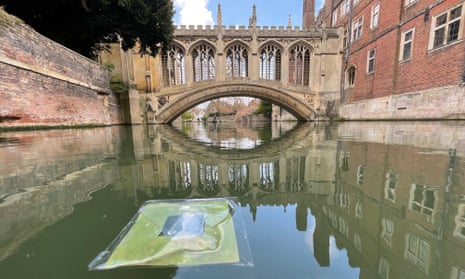Automated floating factories that manufacture green versions of petrol or diesel could soon be in operation thanks to pioneering work at the University of Cambridge. The revolutionary system would produce a net-zero fuel that would burn without creating fossil-derived emissions of carbon dioxide, say researchers.
The Cambridge project is based on a floating artificial leaf which has been developed at the university and which can turn sunlight, water and carbon dioxide into synthetic fuel. The group believe these thin, flexible devices could one day be exploited on a industrial scale.
“Solar panels are excellent at generating electricity and are making a great contribution to the world reaching its net zero aspirations,” said Erwin Reisner, the professor of energy and sustainability at Cambridge University. “But using sunlight to make non-fossil fuels that could be burned by cars or ships takes things a stage further.”
Reisner and his colleagues envisage exploiting the technology to build carpets of artificial leaves that would float on lakes and river estuaries, and use sunlight to convert water and carbon dioxide into the components of petrol and other fuels. “The crucial point is that we are not decarbonising the economy through techniques like these,” Reisner said. “Carbon is still a key component. What we are doing is to ‘defossilise’ the economy. We will no longer be burning ancient sources of carbon – coal, oil and gas – and adding greenhouse gases to the atmosphere, a process that is doing so much damage at present.”

The artificial leaf created at Cambridge takes its inspiration from plants, which use photosynthesis to create food. An early prototype consisted of chemical light absorbers and catalysts that turned carbon dioxide and water into a mixture of carbon monoxide and hydrogen. This combination is known industrially as syngas and it is an intermediary in the production of many chemicals and fuels.
It was a crucial first step. But the device consisted of cumbersome glass sections and protective coatings. Improvements were needed and were made by exploiting thin-film metal oxides and materials called perovskites to create devices that were covered with micrometre-thin, water-repellent layers. The result was a highly effective but non-bulky device that is a millimetre thick and covers an area of 100 square centimetres, a bit like a leaf.
Floated on water, the artificial leaf produces hydrogen and carbon monoxide. “Crucially, we use sunlight to power these transformations,” said Reisner. “And the chemicals that we make this way have already been used to manufacture feedstocks, though it is fuel – like diesel or petrol – that we really want to target. One goal would be to make green sustainable kerosene for the aviation market.”
Ships are another target. About 80% of global trade is transported by cargo vessels that burn fossil fuels and their emissions account for more than 3% of the world’s total industrial output of carbon dioxide. Substituting their fuel with an effective green alternative would play a big role in helping in the battle against global heating.
A crucial advantage of this technology is the fact that it floats and so does not occupy the large amounts of land needed for crops and woodlands. “Clean energy and land use would not be competing with each other,” he added.
Floating farms of solar fuel leaves could also supply coastal settlements and islands, and exploit water in industrial ponds and irrigation canals.
after newsletter promotion
“You could roll up these devices and put them almost anywhere you wanted,” Reisner said. “They are fantastically flexible.”
The team have now created a startup company to commercialise these inventions. “We have taken the science of these systems as far as we can and it is now up to engineers to scale them up so that they can be used on scales large enough to have an impact on carbon emissions,” Reisner told the Observer.
“We need to take solar chemistry from the laboratory and take it to a large-scale industrial level, and that will take millions of pounds of investment.”
